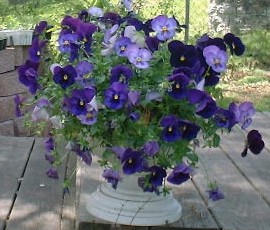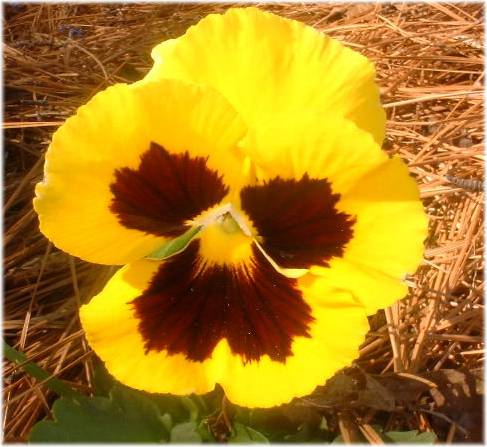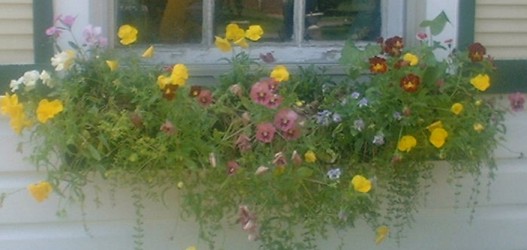 Pansies
rank way up there on my top ten list of favorite annual plants. In
the deep south, they can be planted in September for nearly continuous color
all the way until the next May or June, which makes them a very popular
fall and winter flower. In the harsher winter climates, there are
pansies that will survive in temperatures as low as 15 degrees if mulched
adequately. They may fade briefly during very cold weather, but as
soon as a warm spell comes along they will cheerfully start blooming profusely
again.
Pansies
rank way up there on my top ten list of favorite annual plants. In
the deep south, they can be planted in September for nearly continuous color
all the way until the next May or June, which makes them a very popular
fall and winter flower. In the harsher winter climates, there are
pansies that will survive in temperatures as low as 15 degrees if mulched
adequately. They may fade briefly during very cold weather, but as
soon as a warm spell comes along they will cheerfully start blooming profusely
again.
 Pansies
are the largest members of the Viola family, which includes Violas,
Violets, and Johnny-Jump-Ups.
They an be found in many colors, including yellow white, rose, blue, purple,
white, and wine. They provide low color throughout the winter months
and are perfect for adding cheer to walkways,
containers, and borders when
not much else will bloom there. They make excellent companions for
many of the spring bulbs, such as tulips, iris, and daffodils, and are good
rock garden plants. In days past, Pansies sported the familiar "faces"
on their petals, but breeding has eliminated this characteristic in some
of the newer cultivars. Personally, I like the faces because they
provide something of a tapestry effect when used in mass plantings.
Pansies
are the largest members of the Viola family, which includes Violas,
Violets, and Johnny-Jump-Ups.
They an be found in many colors, including yellow white, rose, blue, purple,
white, and wine. They provide low color throughout the winter months
and are perfect for adding cheer to walkways,
containers, and borders when
not much else will bloom there. They make excellent companions for
many of the spring bulbs, such as tulips, iris, and daffodils, and are good
rock garden plants. In days past, Pansies sported the familiar "faces"
on their petals, but breeding has eliminated this characteristic in some
of the newer cultivars. Personally, I like the faces because they
provide something of a tapestry effect when used in mass plantings.
Pansies can be propagated by
seed, cuttings, or division. When taking cuttings, do it in late summer
or fall and cut just below the stem joint. Plant in fertile soil and
keep moist. Division should be done in spring or fall. Choose
a sturdy plant, and divide into several pieces, being sure to leave some
root attached to each one.

Pansies prefer rich, moist,
well drained soil and full sun. They will start to get leggy when
the weather warms, and they can be moved to a shady, cool location for the
duration if you want to save them for re-planting in the fall. They
self seed rather readily, and some cultivars emit a light fragrance when
brushed.
The uses for Pansies are varied.
They make excellent cut flowers when used in a short vase. I saw a
suggestion recently that said to put the cut flowers in cool water in a
cool place for a few hours before arranging, so that the stems will become
stiffer and easier to manipulate. The flowers can also be floated
in a shallow bowl for an interesting mosaic-like effect.
 The
flowers of Pansies are edible, and have a minty taste. They can be
candied (see Violets
for instructions) and used on cakes and other confections, and are also
increasing in popularity as colorful additions to green salads. The
flowers can be floated in a punch bowl for a decorative touch, and used
to scent a sugar bowl. Pansy flowers will also color and flavor vinegars
and add flavor to custards.
The
flowers of Pansies are edible, and have a minty taste. They can be
candied (see Violets
for instructions) and used on cakes and other confections, and are also
increasing in popularity as colorful additions to green salads. The
flowers can be floated in a punch bowl for a decorative touch, and used
to scent a sugar bowl. Pansy flowers will also color and flavor vinegars
and add flavor to custards.
 Directly
above and to the right
are two images of Johnny Jump Ups, a close relative of the Pansy with the
same growing requirements. Click on the image to see the full-sized
picture.
Directly
above and to the right
are two images of Johnny Jump Ups, a close relative of the Pansy with the
same growing requirements. Click on the image to see the full-sized
picture.
 Pansies
rank way up there on my top ten list of favorite annual plants. In
the deep south, they can be planted in September for nearly continuous color
all the way until the next May or June, which makes them a very popular
fall and winter flower. In the harsher winter climates, there are
pansies that will survive in temperatures as low as 15 degrees if mulched
adequately. They may fade briefly during very cold weather, but as
soon as a warm spell comes along they will cheerfully start blooming profusely
again.
Pansies
rank way up there on my top ten list of favorite annual plants. In
the deep south, they can be planted in September for nearly continuous color
all the way until the next May or June, which makes them a very popular
fall and winter flower. In the harsher winter climates, there are
pansies that will survive in temperatures as low as 15 degrees if mulched
adequately. They may fade briefly during very cold weather, but as
soon as a warm spell comes along they will cheerfully start blooming profusely
again. Pansies
are the largest members of the Viola family, which includes Violas,
Pansies
are the largest members of the Viola family, which includes Violas,
